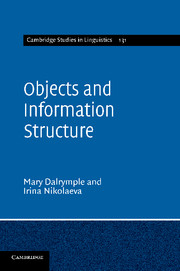Book contents
- Frontmatter
- Contents
- Preface and Acknowledgements
- List of Abbreviations
- 1 Introduction
- 2 Syntactic assumptions
- 3 Information structure in grammar
- 4 Syntax and information structure
- 5 Topicality and grammatical marking
- 6 Topical marking of nonsubjects
- 7 Topicality and DOM
- 8 Primary and secondary objecthood and DOM
- 9 Multiple objects and grammatical alignment
- 10 Semantic features, topicality and grammaticalisation
- 11 Conclusion
- References
- Author Index
- Language Index
- Subject Index
7 - Topicality and DOM
Published online by Cambridge University Press: 05 October 2012
- Frontmatter
- Contents
- Preface and Acknowledgements
- List of Abbreviations
- 1 Introduction
- 2 Syntactic assumptions
- 3 Information structure in grammar
- 4 Syntax and information structure
- 5 Topicality and grammatical marking
- 6 Topical marking of nonsubjects
- 7 Topicality and DOM
- 8 Primary and secondary objecthood and DOM
- 9 Multiple objects and grammatical alignment
- 10 Semantic features, topicality and grammaticalisation
- 11 Conclusion
- References
- Author Index
- Language Index
- Subject Index
Summary
We have seen that some languages treat nonsubject topics specially in terms of grammatical marking: in such languages, topic marking can apply to a variety of nonsubject elements, and any one of a number of grammatical roles can be the target of topic marking. In this chapter we discuss languages in which only topical objects are marked, giving rise to DOM. In some of these languages DOM depends on topicality alone, while in others topicality-based DOM works together with semantic factors.
Objects as grammaticalised secondary topics
Chapter 6 discussed languages in which a whole range of salient nonsubject elements in the clause can bear topical marking: direct objects, some oblique objects and adjuncts, and sometimes even possessors. Crucially, objects are always candidates for marking of this type: we do not know of any language in which nonsubject topic marking is unavailable for objects, and in fact in many languages grammatical marking of topical nonsubject arguments is restricted to objects. This is DOM.
Languages with DOM conditioned by information structure overtly mark a close association between topics and objects, just as some languages require and mark a close association between topics and subjects. Topics are more likely than nontopics to be objects — or, more generally, to appear high on the grammatical function hierarchy. Croft (1991) observes that subjects are typified by “high topicality”, while “medium topicality” is characteristic of objects, in contrast to other grammatical functions.
- Type
- Chapter
- Information
- Objects and Information Structure , pp. 125 - 139Publisher: Cambridge University PressPrint publication year: 2011

